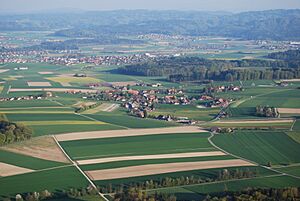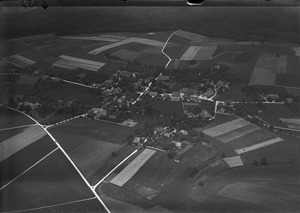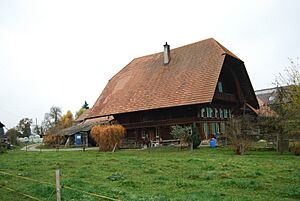Iffwil facts for kids
Quick facts for kids
Iffwil
|
||
|---|---|---|

Iffwil village entrance
|
||
|
||
| Country | Switzerland | |
| Canton | Bern | |
| District | Bern-Mittelland | |
| Area | ||
| • Total | 5.06 km2 (1.95 sq mi) | |
| Elevation | 580 m (1,900 ft) | |
| Population
(Dec 2020 )
|
||
| • Total | 428 | |
| • Density | 84.58/km2 (219.1/sq mi) | |
| Postal code |
3303
|
|
| Surrounded by | Bangerten, Etzelkofen, Grafenried, Jegenstorf, Scheunen, Zuzwil | |
Iffwil is a small town, also called a municipality, located in the Bern-Mittelland area. It is part of the canton of Bern in Switzerland.
Contents
History of Iffwil
Iffwil was first mentioned in old records in the year 1148. Back then, it was known as Iffenwilere.
Ancient Discoveries
Around the municipality, people have found scattered items from the Neolithic period. This was a time when people first started farming and using stone tools. Also, a Hallstatt grave mound was discovered in the Iffwilerwald. A grave mound is a large pile of earth or stones over a burial. The Hallstatt culture was an early Iron Age culture in Europe.
Medieval Times
A castle was mentioned near the village in 1346, but today only its foundations remain. During the Middle Ages, different landowners owned parts of the village. These included the Counts of Kyburg and the Lords of Jegistorf and Seedorf.
In 1332, the Lords of Seedorf sold some land and the village's low court to citizens of Bern. A low court handled smaller legal cases. Between 1334 and 1361, most of these citizens sold or gave their land in the village to the Niedere Spital (Lower Hospital) in Bern. The Hospital then put someone in charge to manage their properties in Iffwil.
A village called dorf ze Ober Iffwil (Upper Iffwil village) was last mentioned in 1356. Sometime after that, this village was abandoned.
Modern Changes
During the 20th century, Iffwil changed a lot. It went from being a farming village to a commuter town. A commuter town is where many people live but travel to a bigger city for work. Iffwil's location near Bern and important roads made it a good place for commuters to live.
New neighborhoods like Bergacker and Dorf were built starting in 1965 to house the growing population. Today, about two-thirds of the people living in Iffwil travel to jobs in nearby cities.
Geography of Iffwil
Iffwil covers an area of about 5.0 square kilometers (1.9 square miles). A large part of this land, about 55.1%, is used for farming. Forests cover 36.4% of the area. The remaining 7.9% is built up with buildings and roads.
Land Use
- Of the built-up area, 2.6% is for houses and other buildings.
- Roads and other transport areas make up 5.1%.
- All the forested land is covered with thick forests.
- For farming, 46.8% of the land is used for growing crops.
- Another 6.7% is used for pastures where animals graze.
- A small part, 1.6%, is used for orchards or vineyards.
The municipality is located on the Rapperswil plateau, which is a flat, elevated area.
Administrative Changes
On December 31, 2009, the old district of Amtsbezirk Fraubrunnen, which Iffwil belonged to, was closed down. The very next day, January 1, 2010, Iffwil became part of a new administrative area called Verwaltungskreis Bern-Mittelland.
Coat of Arms of Iffwil
The blazon (official description) of Iffwil's municipal coat of arms is quite unique. It shows a shield divided into two parts by a battlements pattern. The top part is silver, and the bottom part is black. In the silver top part, there is a black bear paw that looks like it has been cut off.
Population and People in Iffwil
Iffwil has a population of around 443 people as of 2018. In 2010, about 1.9% of the people living here were foreign nationals. Over ten years (from 2000 to 2010), the population slightly decreased by 2.1%. More people moved into the town (3.1%) than moved out, and there were more births than deaths (4.7%).
Languages Spoken
Most people in Iffwil speak German. In 2000, about 98.1% of the population spoke German as their main language. A small number of people spoke French (0.5%) or Spanish (0.2%).
Where People are From
In 2008, the population was almost evenly split between males (50.6%) and females (49.4%). Most people were Swiss citizens. In 2000, about 29.1% of the people were born in Iffwil itself. Another 48.9% were born in the same canton (Bern). About 14.8% were born elsewhere in Switzerland, and 3.1% were born outside Switzerland.
Age Groups
As of 2010, young people (0–19 years old) make up 21.4% of the population. Adults (20–64 years old) are the largest group at 64%. Seniors (over 64 years old) make up 14.6%.
Family Life
In 2000, there were 165 single people who had never been married. There were 213 married people, 19 widows or widowers, and 16 divorced individuals.
There were 28 households with only one person and 12 households with five or more people. Most apartments (89.3%) were lived in all the time. A few (7.1%) were used only during certain seasons, and 3.6% were empty. In 2011, only about 0.57% of apartments were empty.
Population Over Time
The chart below shows how Iffwil's population has changed over many years:

Economy of Iffwil
In 2011, Iffwil had a very low unemployment rate of 0.44%. This means almost everyone who wanted a job had one. In 2008, there were 122 people working in the municipality.
Economic Sectors
Jobs are often divided into three main groups:
- Primary sector: This includes jobs that get raw materials from nature, like farming or mining. In Iffwil, 49 people worked in this sector, mostly in agriculture. There were about 15 businesses in this area.
- Secondary sector: This involves making things, like in factories or construction. Only 3 people worked in this sector in Iffwil, with 3 businesses. One job was in manufacturing, and two were in construction.
- Tertiary sector: This is the service sector, where people provide services to others. Examples include shops, hospitals, or schools. In Iffwil, 70 people worked in this sector, with 16 businesses.
In 2008, there were 89 full-time equivalent jobs. This means if you add up all the hours worked, it's like 89 people working full-time. About 43.9% of the workforce were women.
Commuting
In 2000, 29 workers came into Iffwil for their jobs, while 170 workers left Iffwil to work somewhere else. This shows that many people who live in Iffwil commute out for work. About 16.4% of working people used public transportation to get to work, and 51.6% used a private car.
Religion in Iffwil
Based on the 2000 census, here's a look at the religious groups in Iffwil:
- About 7.5% of the population (31 people) were Roman Catholic.
- A large majority, 75.8% (313 people), belonged to the Swiss Reformed Church.
- About 7.26% (30 people) belonged to other Christian churches.
- One person was Hindu.
- About 9.69% (40 people) said they belonged to no church, or were agnostic (meaning they don't know if God exists) or atheist (meaning they don't believe in God).
- About 3.15% (13 people) did not answer the question about their religion.
Education in Iffwil
In Iffwil, about 41.9% of the population (173 people) have completed upper secondary education. This is schooling after primary school that is not always required. Also, 16.0% (66 people) have completed higher education, like attending a university or a Fachhochschule (a type of professional university). Of those with higher education, most were Swiss men (74.2%) or Swiss women (22.7%).
Bern School System
The Canton of Bern has a specific school system:
- It starts with one year of optional Kindergarten.
- Then, there are six years of Primary school.
- After that, students go to three years of required lower Secondary school. Here, students are grouped based on their abilities.
- After lower Secondary, students can choose to continue their schooling or start an apprenticeship (learning a trade on the job).
Local Schools
During the 2010–11 school year, 42 students attended classes in Iffwil. There were no kindergarten classes in the municipality. The municipality had 2 primary classes with 42 students. A small number of these primary students (4.8%) had a different first language than the language used in the classroom.
In 2000, 4 students came to Iffwil from other towns to attend school. However, 22 residents of Iffwil went to schools outside the municipality.
See also
 In Spanish: Iffwil para niños
In Spanish: Iffwil para niños








